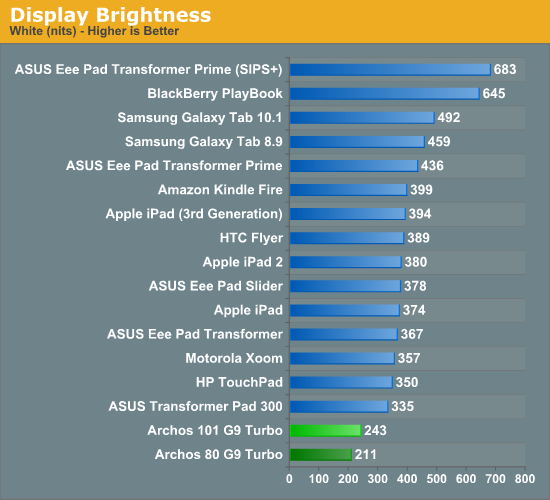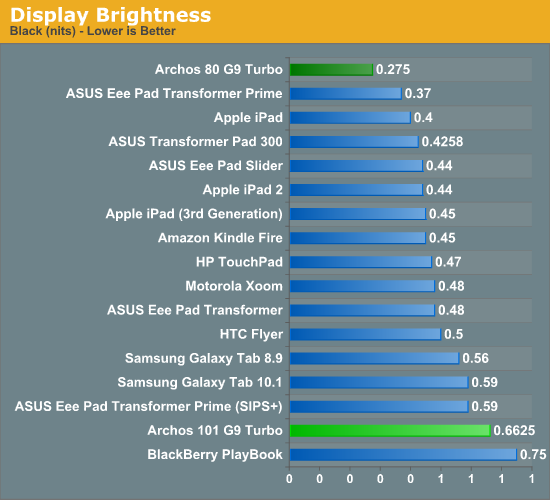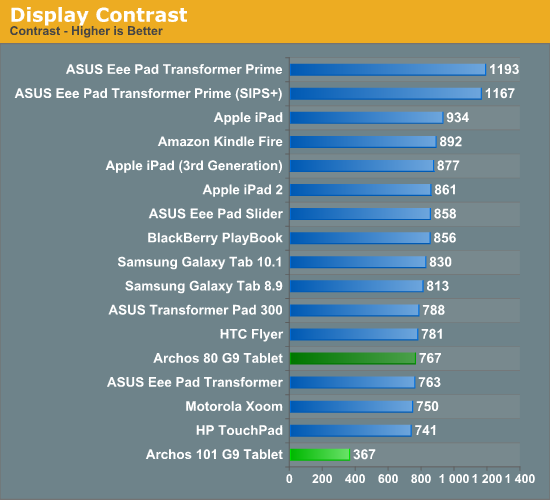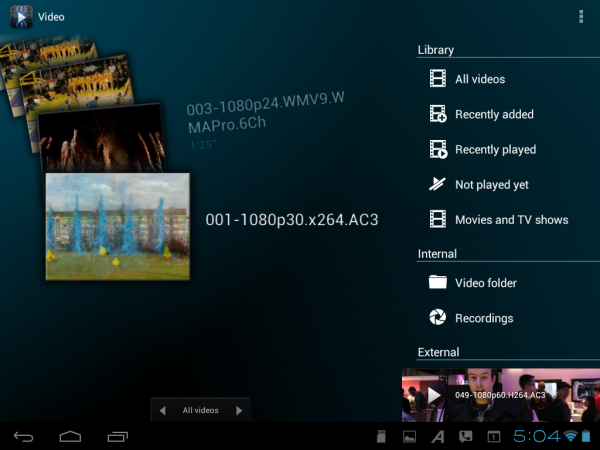The Display
The 80 and 101 feature very different LCD panels, and their trade-offs leave neither with the perfect set-up. Each display is the dimmest of all the displays we’ve ever tested, with the 80 barely making it to 200 nits of brightness. The weak backlight doesn’t do any favors for the displays contrast either.



Color representation is good, though not even close to the new iPad nor the TF Prime. But in practice, something strange happens. The 10.1” display accounts very well for itself, distancing itself from it’s smaller kin in one very important way, viewing angles. When gaming or watching video on the 80, it is very easy to tilt the device in such a way that it’s very nearly totally washed out. The 101, on the other hand, seems to falter only slightly in viewing angles. The 80's behavior is irregular, too; viewed from the left or from above the display actually looks decent. Viewed from ever so slightly to the right or below and the colors become washed out and distorted.
_575px.jpg)
At more than twice the brightness, the Galaxy Tab 10.1 outshines both Archos G9s outdoors.
I wish I could say at this point that the low brightness, passable color representation and less than ideal viewing angles were ultimately a non-issue. Unfortunately, in a tablet designed for media consumption, the display needs to be good, if not great. So, strike one for Archos.
Software

While the vast majority of tablet manufacturers have faltered in updating their previously released tablets to Android 4.0, Archos pushed an update to the entire G9 line this March. Part of their expedience was the lack of UI skinning. Their main focus in modifying the software was providing excellent codec and container support. Our media test suite is brutal, and gives most HTPC’s a run for their money, let alone most mobile devices. Overall, the G9s did very well, passing about half the tests, including some impressively esoteric container and codec combinations. Even subtitle and audio codec support was rather strong, and this tablet will suffice for nearly any DVD or Blu-Ray rip. A big stumbling block for the tablets was playing AVCHD content, which was blocky and stuttery; so digital camcorder aficionados shouldn’t expect to use this as a preview device. Windows Media Center fans will have to transcode their recorded television to alternate formats before playback on the G9, as both .wtv and .dvr-ms formats were incompatible. Lossless audio content in DTS-HRA and Dolby TrueHD formats were unplayable, though FLAC and DTS-MA work fine.

Truly, though, you’re not likely to find this sort of out of the box compatibility in any other mobile device; unfortunately, that experience isn’t quite out of the box. The most common video codecs for commercial media fall under the MPEG variants, and AC3, an analogue of Dolby Digital, is the most common audio codec. In order to play files encoded with MPEG or AC3 streams, you must first purchase a plug-in from the Archos Store for $10. The web store isn’t quite touch friendly so you’ll want to do this from your computer and then transfer the file to the tablet. As a device targeted at media consumption, shipping without MPEG and AC3 playback is a bit absurd, so consider this part of the cost of the device.
All of this playback happens through Archos Media Center (though the icon is labeled simply Video), using the Android Video Player yields more pedestrian results. The software has a good interface and quickly loads previews and features intuitive controls for changing audio tracks, subtitles and peeking at stream information. In testing the software would occasionally hang or crash all together. These hangs typically succeeded attempting to play an incompatible file so don’t expect to see that behavior regularly, only when you’re testing 60+ different video files.
Beyond the media playback capabilities, it’s all vanilla Ice Cream Sandwich. The interface is smooth and without hiccups, touch response was good on both tablets, and app switching was quick, though switching between larger apps could elicit some delay. In testing the tablets got a little irritable, occasionally prone to freezes and restarts, this is very atypical behavior though. In regular day to day use both tablets behaved quite well.



_575px.jpg)


















39 Comments
View All Comments
jjj - Wednesday, May 23, 2012 - link
Wish you had the HDD versions too,to see how the perf and battery life are impacted.As for the tablet ,too bad the screen is TN.
Why no wifi tests? And ofc, as always, wish you had better battery life tests and some storage perf testing.
tipoo - Wednesday, May 23, 2012 - link
Yeah, I'm curious how the HDD would perform with an OS like Android. It seems tablet OSs are well optimized for NAND and predictable read/write speeds unlike what you get with hard drives.Souka - Thursday, May 24, 2012 - link
*sigh*fast cpu = good
poor display and battery life = bad
too many other options out there for a tablet that misses out on 2 of 3 important factors in a tablet design.
My $.02
dkfx77 - Thursday, May 24, 2012 - link
Well, in fact the OS doesnt use the HDD. They got a 4GB flash mem for the system. Then the HDD is only used for your files, not for Android.So I guess, as far as u dont play a video or listen to mp3 files, it wont affect the battery that much...
dkfx77 - Thursday, May 24, 2012 - link
It also saves the HDD life expectancy cause you know, not read every 10sec...JasonInofuentes - Wednesday, May 23, 2012 - link
I worry about our WiFi tests, for a few reasons. First, the objectiveness of our reception tests are marred by the fact that our data is different for each of our testers. We test in our homes, and since we don't all live together in a massive AnandVille campus in North Carolina, that means that each of us would want to test WiFi reception we would each have our own test routine and our own test data. Seeing as how I would be comparing it to just the Samsung Galaxy Tab 10.1, my data wouldn't be all that interesting. I did take the tablets on a walk along side that Galaxy Tab, to see when they'd drop out, and they all dropped out at the same time. Those outdoor shots are actually on my deck, as far from my router as you can get and still be on the property, and all devices acted the same.As far as our WiFi throughput tests, that's another of our tests that we're hit or miss on reporting. With an all plastic chassis there should be no issues like the Transformer Prime experienced. And in practice I had no issues using the device on WiFi, though I didn't do any large file downloads. Will remember your note next time, though.
All that said, what's wrong with our battery life tests?!? They're consistent and getting better! We're working to tweak them so there's less opportunities for browsers to cache the files and bolster their Web Browsing scores. And as for the playback tests, I love watching Quantum of Solace over and over again. Don't you? :)
silverblue - Thursday, May 24, 2012 - link
Trade for Casino Royale. ;)Penti - Thursday, May 24, 2012 - link
The screen is MVA, Archos used to use TN and I would have rejected them then basically because of that detail. There might exist some good TN-panels but on a tablet I want something with good viewing angles and the Archos screen (don't have one) should do that. More worryingly a TN panel would have washed out in sunlight and not be viewable in strong sunlight outside though. That said I still liked following them because of their long heritage in the PMP/Tablet field. Acer was also someone I did not count when they used TN screens.Other tablets that use MVA screens is for example the Motorola Xoom. PVA is used on some of Acer's later models too. You should really do it justice by evaluating the actual use of the display, describing it and give a small representation of how it is to look at subjectively, that it has a weak backlight (or backlight setting) doesn't really say if it is worse then a HTC Flyer screen which is a TN-screen with low (-er) viewing angles and prone to wash out so it would be trouble to use outside in the sun. At least you mentioned it would be pressed and hardly readable or barely in sunlight in the HTC Flyer review.
Penti - Thursday, May 24, 2012 - link
Also you can get the Archos G9's (both 101 and 80) with 16GB internal storage at least in Europe. Cheaper to get a MicroSD card though. Don't know if they increase the internal app storage with the larger model.Also I guess it's good enough that you review the screens and gave a more in depth representation at the display page/section. Calling it TN might have stretch it and gave the wrong impression though. Good to point out that the quality and uniformity seems to be worse on the 80 though. Others have described the screen on the 80 G9 as good or good enough definitively not the worse there is or worse in class and at least have not been bothered (much) by shifting colors with normal viewing angles (say up to 45). The 101 might still be noticeable better though. Nobody expects Archos to have the best screens but adequate is enough.
As long as their customers is happy with it. Might not have much to put up against newer ICS tablets as far as the 101 is concerned though, but at least it's not running Tegra 2. Then again it's only a speed bump on an older model. It is not price competitive any more.
Penti - Thursday, May 24, 2012 - link
Sony Mobile is still based in Lund (Sweden, they moved their London head office back to where most of their engineers are) with a few thousand employees there. Their new Japanese CEO will be based in Lund and Tokyo. Good to see it being taken over by the Japanese that might give them better management culture though. The Tablets was a venture from Sony in Japan though, don't not if they will fold it into Sony Mobile. They were really late to get some good or at least decent Android devices out but lately recovered some and has a good mind share in Sweden. Don't know how the other guys in Lund fairs presumably ST-Ericsson (former EMP guys) took a huge hit when Nokia decided they wouldn't release any (more) Symbian or MeeGo products on their chips despite being signed on as an supplier, they even had a MeeGo BSP more or less ready. At least they seem to have entered the Android game now with some customers in China (with their built in TD-SCDMA baseband) plus now on new Sony Mobile phones. It's basically up the Japanese to not force all the mobile professionals (not working on base stations) to go to the Chinese companies which already has a presence here. Some plurality is good and some continuance is good rather then closing shop and reorganizing in other companies which means some stuff would just fall out of history.